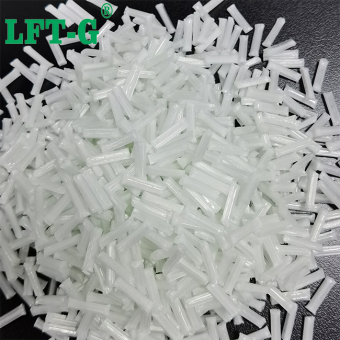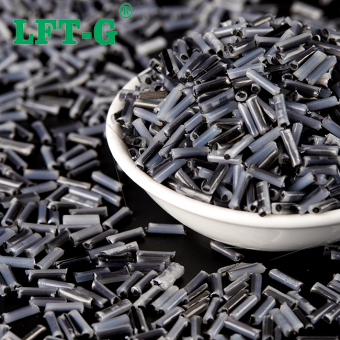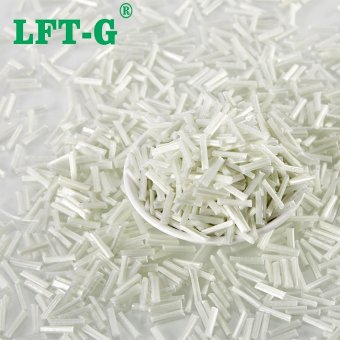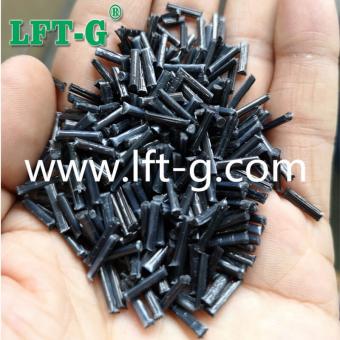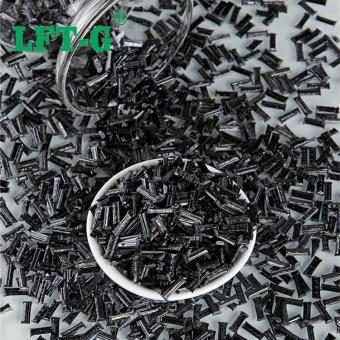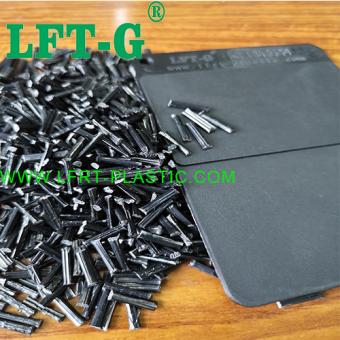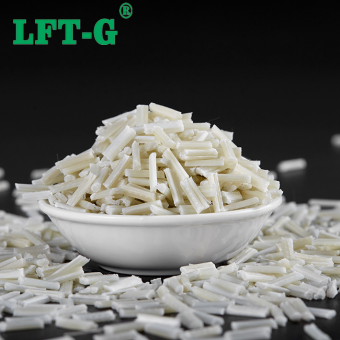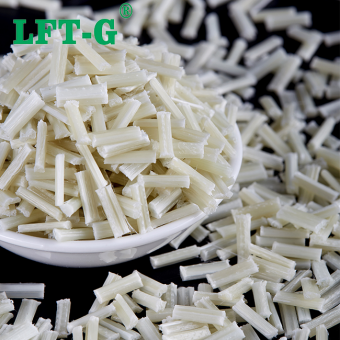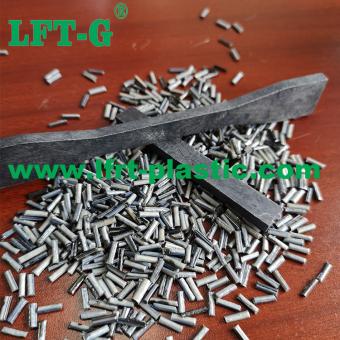-
Raw material composite Polypropylene Long Glass Fiber40Product introduction Long glass fiber reinforced polypropylene (PP-LGF) material has been widely used in the automobile industry because of its advantages of light weight, high specific strength, good heat resistance and recycling, etc. Long glass fiber reinforced polypropylene (PP-LGF) material has low cost, high specific strength and high heat resistance and so on. Since it was developed in the early 1980s, The hope is to replace some metal or engineering plastics in car parts. Polypropylene Long Glass Fiber40
- glass fiber filling
- cost effectively reduce
- instead medal
- excellent resistance to creep and fatigue
- low warpage
- customized color
Tags :
-
PA6 Polyamide 6 fiiling Long Carbon Fiber composite indusrial raw material lcf40Product number: PA6-NA-LCF40 Product fiber: 20%-60% Product application: Suitable for manufacturing helmets, Car bumps and Robotic and arms etc. Product feature: High toughness, Light weight, High strength, Wear strength, Corrosion resistance, Creep resistance, Conduction, Heat transfer.
- Black color
- Heat transfer
- Sample available
- Customized products
- Manufacturing use
- Instead medal
Tags :
-
LFT-G TPU injection grade filling Long glass fiber LGF for power toolsProduct number: TPU-NA-LGF Fiber filling: 20%~60% Product feature: High toughness, High rigidity, Low water absorption, High dimensional stability, Chemical resistance, Good product appearance Product application: Car doors and windows, Safty toe, Mechanical parts, Pneumatic nail gun boxes, Professional power tools, Nuts and bolts, etc.
- Good product appearance
- Chemical resistance
- Original color
- Car doors and windows
- Long fiber glass
Tags :
-
High temperature resistance PA12 long carbon fiber composite resin sports parts automotiveFiber specification:20%-60% Product grade:Narmal gradeview more
-
High value materials PEEK fill lcf carbon reinforced composite sample availableAs a kind of special engineering plastic, PEEK has excellent comprehensive performance.
- poly-ether-ether-ketone
- PEEK composite
- High impact resistance material
- long carbon filling plastic
- China made products
- Instead medal plastic
Tags :
-
Nylon 66 high performance PA66 long carbon fiber composite materials for aerospace filedsWhat is PA66 plastic? Polyadipyladipylenediamine, commonly known as nylon -66, is a thermoplastic resin, generally made from adiponic acid and hexadipamine condensation. Insoluble in general solvents, only soluble in m-cresol, etc. High mechanical strength and hardness, rigidity. It can be used as engineering plastics, mechanical accessories such as gears, lubricating bearings, instead of non-ferrous metal materials to make machine shells, automotive engine blades, and can also be used to make synthetic fibers. PA66 plastic raw material is translucent or opaque opalescent crystalline polymer, with plasticity. Density 1.15g/cm3. Melting point 252℃. Embrittlement temperature -30℃. Thermal decomposition temperature is greater than 350℃. Continuous heat resistance 80-120℃, balanced water absorption rate of 2.5%. Resistant to acid, alkali, most aqueous inorganic salts, alkyl halides, hydrocarbons, esters, ketones and other corrosion, but easy to phenol, formic acid and other polar solvents. It has excellent wear resistance, self lubricity and high mechanical strength. But the water absorption is larger, so the dimensional stability is poor. What is Long Carbon Fiber? In the modified engineering plastics industry, long fiber reinforced composite material refers to long carbon fiber, long glass fiber, aramid fiber or basalt fiber and polymer matrix, through a series of special modification methods to produce composite materials. The biggest characteristic of long fiber composites is that they have superior properties that the original materials do not have. If they are classified according to the length of the added reinforcement materials, they can be divided into long fiber, short fiber and continuous fiber composites. As mentioned in the beginning, long carbon fiber composite material is a kind of long fiber reinforced composite material, which is a new fiber material with high strength and high modulus fiber. LCF carbon fiber composite exhibits high strength along the fiber axis, and has the characteristics of high strength and light weight. It has the comprehensive mechanical properties such as density, specific strength and specific modulus that are incomparable to other materials. It is a new material with excellent mechanical properties and many special functions. What are the properties of Long Carbon fiber? Corrosion resistance: LCF carbon fiber composite material has good corrosion resistance, can adapt to harsh working environment; Uv resistance: strong ability to resist UV, products by UV damage problem is small; Wear resistance and impact resistance: compared with the general material advantage is more obvious; Low density: lower than the density of many metal materials, can achieve the purpose of lightweight; Other properties: such as reducing warpage, improving rigidity, impact modification, increasing toughness, electrical conductivity and so on. Compared with glass fiber, LCF carbon fiber composite has higher strength, higher rigidity, lower weight, and excellent electrical conductivity. What is the application fileds of PA66-LCF? 1. Military industry LFT long carbon fiber composite has very high specific strength and stiffness, and has the characteristics of corrosion resistance, fatigue resistance, high temperature resistance and low thermal expansion coefficient, etc. LCF carbon fiber composite is widely used in rocket, missile, military aircraft, personal protection and other military fields at home and abroad. Compared with conventional materials, long carbon fiber composites allow for continuous improvements in the performance of military equipment, such as reducing the weight of warships by 20 to 40 percent. At the same time, LCF carbon fiber composite material can overcome the metal material is easy to be corroded, easy to fatigue and other shortcomings, improve and enhance the durability of military products. Currently, more than 40 percent of LCF carbon fiber composite materials are used in some advanced military helicopters, and even more in unmanned aerial vehicles. In addition to aircraft, Marine warships also appear long carbon fiber composite material figure, because long carbon fiber composite material can withstand the corrosion of seawater and a variety of chemical impurities, has a long service life, more durable than steel warships, lower maintenance costs, has become an important strategic material for the development of modern defense military weapons and equipment. 2. Home appliance field LCF carbon fiber composite material has low density, good chemical resistance, excellent performance and other characteristics, has gradually become the home appliance industry's preferred modified engineering plastics, its usage accounts for about 30% and is on the rise. Moreover, home appliances are more and more intelligent and personalized, and the modified performance requirements of materials are higher. So it's no surprise that long carbon fiber composites are chosen by th...
- LFT-G brand
- polyadipyladipdiamine
- composite material
- Thermoplastic resin
- Synthetic fibre
- Instead medal material
Tags :
-
PBT filling long glass fiber LGF injection grade composite high quality natural colourPBT-LGF Polybutanediol terephthalate (PBT) has excellent comprehensive properties, such as high crystallinity, rapid prototyping, weather resistance, low friction coefficient, high thermal deformation temperature, good electrical properties, excellent mechanical properties, fatigue resistance, can be ultrasonic welding. However, its notched impact strength is low, forming shrinkage rate is large, hydrolysis resistance is poor, easy to be eroded by halogenated hydrocarbons, after glass fiber reinforcement, because of the product longitudinal and horizontal shrinkage is inconsistent easy to warping products. With its excellent comprehensive performance, PBT is widely used in electronic and electrical appliances, automobile industry, machinery, instruments and household appliances and other fields. Common problem & Solvement Glass fiber reinforced PBT material warps easily Reasons: Warping is the result of uneven shrinkage of the material. The warping of the product can be caused by the orientation and crystallization of the components in the material, the improper technological conditions used in the injection molding, the wrong shape and position of the gate in the mold design, and the uneven thickness of the wall in the product design. The warping of PBT/GF composites is mainly due to the fact that the orientation of the glass fiber in the flow direction restricts the shrinkage of the resin, and the induced crystallization of PBT around the glass fiber strengthens this effect, making the longitudinal (flow direction) shrinkage of the product less than the transverse (perpendicular to the flow direction). This uneven shrinkage leads to the warping of PBT/GF composites. Solution: 1. Add minerals and use the shape symmetry of mineral fillers to reduce the anisotropy caused by the glass fiber orientation; 2. Add amorphous materials to reduce the crystallinity of PBT and reduce the uneven shrinkage caused by crystallization, such AS ASA or AS, but they have poor compatibility with PBT, so appropriate compatibilizers need to be added; 3. Adjust injection molding process, such as increasing mold temperature and increasing injection cycle appropriately. Glass fiber reinforced PBT surface floating fiber problem Reasons: The causes of floating fiber are more complex, in short, there are mainly the following aspects 1. The compatibility of PBT and glass fiber is very poor, resulting in the two can not effectively bond together; 2. The viscosity of PBT and glass fiber is very different, resulting in a tendency of separation between the two in the flow process. When the separation effect is greater than the adhesive force, the separation will occur, and the glass fiber will float to the outer layer and leak out; 3. The existence of shear force will not only lead to local viscosity differences, but also destroy the interface layer melt viscosity on the glass fiber surface, the smaller the interface layer is damaged, the smaller the bonding force on the glass fiber. When the viscosity is low to a certain degree, the glass fiber will get rid of the PBT resin matrix and gradually accumulate to the surface and expose. 4. Influence of mold temperature. Due to the low temperature of the mold surface, the glass fiber with light weight and fast condensation is frozen instantaneously. If it is not fully surrounded by melt in time, it will be exposed and form "floating fiber". Solution: 1) Add compatibilizers, dispersants and lubricants to improve the floating fiber problem. For example, the use of special surface treatment of glass fiber, or adding compatibilizers (such as: SOG, a well-flowing PBT modified compatibilizer) through the "bridge" effect, increase the adhesion of PBT and glass fiber. 2) Optimize the molding process to improve the floating fiber problem. Higher injection molding temperature and mold temperature, larger injection molding pressure and back pressure, faster injection molding speed, lower screw speed, can improve the floating fiber problem to a certain extent. The glass fiber reinforced PBT injection molding process is easy to produce more mold scale Reasons: The formation of mold scale is caused by the high content of small molecules or the poor thermal stability of materials. Compared with other materials, PBT is easy to generate mold scale due to its oligomer and small molecule residue rate usually in the range of 1%-3%. And after the introduction of glass fiber, more obvious. This will lead to the continuous processing process, the need to clean the mold regularly, resulting in low production efficiency. Solution: 1) Reduce the amount of small molecule additives (such as lubricant, coupling agent, etc.), try to choose polymer additives; 2) Improve the thermal stability of PBT and reduce the small molecular products produced by thermal degradation during processing; PBT Application Widely used in machinery, electronic and electrical, automotive industry and household appliances and other fields. Rel...
- Polybutylene terephthalate
- Semi-crystalline thermoplastic polyester
- PBT resin
- Electronic parts material
- Industry use plastic
Tags :
-
Lft-g high strength high toughness instead medal PA12 LGF made by own factory 24h onlinePA12 Long Glass Fiber Long carbon chain nylon is nylon with an amide group in the main chain repeating unit of nylon molecule, and the length of methylene between the two amide groups is greater than 10. We call it long carbon chain nylon, including nylon 11, nylon 12, etc. PA12 is nylon 12, also known as polydodecactam, polylauractam, is a long carbon chain nylon. The basic material for its polymerization is butadiene, a semi-crystalline - crystalline thermoplastic material. Nylon 12 is the most widely used long carbon chain nylon, in addition to most of the general properties of nylon, low water absorption, and has high dimensional stability, high temperature resistance, corrosion resistance, good toughness, easy processing and other advantages. Compared with PA11, another long carbon chain nylon material, the price of butadiene, the raw material of PA12, is only one third of the price of castor oil, the raw material of PA11. It can replace PA11 and be applied in most scenes, and has a wide range of applications in automobile fuel pipe, air brake hose, submarine cable, 3D printing and many other fields. In long chain nylon, compared with other nylon materials, PA12 has great advantages, such as the lowest water absorption rate, the lowest density, low melting point, impact resistance, friction resistance, low temperature resistance, fuel resistance, good dimensional stability, good anti-noise effect. PA12 has the properties of PA6, PA66 and polyolefin (PE, PP) at the same time, achieving the combination of lightweight and physical and chemical properties, and has advantages in performance. The following table shows the performance data: Performance of PA12 There are a large number of non-polar methylene groups in nylon 12, which makes nylon 12 molecular chain more compliant. The amide group in nylon 12 is polar, and the cohesion energy is very large, it can form hydrogen bonds between the molecules, so that the molecular arrangement is regular. Therefore, nylon 12 has high crystallinity and high strength. Nylon 12 has low water absorption, good low temperature resistance, good air tightness, excellent alkali and oil resistance, medium resistance to alcohol, inorganic dilute acid and aromatic hydrocarbons, good mechanical and electrical properties, and is a self-flameout material. We can offer you: 1. LFT&LFRT material technical parameters and leading edge design; 2. Mold front design and recommendations; 3. Provide technical support such as injection molding and extrusion molding. System Certification Quality Management System ISO9001/1949 Certification National Laboratory Accreditation Certificate Modified Plastics Innovation Enterprise Honorary Certificate Heavy metal REACH & ROHS testing Frequently asked questions 1. Does long glass fiber and long carbon fiber injection have special requirements for injection molding machines and molds? A: There are certainly requirements. Especially from the product design structure, as well as the injection molding machine screw nozzle and mold structure injection molding process must consider the requirements of long fiber. 2. The product is easy to brittle, so changing to use long fiber reinforced thermoplastic materials can solve this problem? A: The overrall mechanical properties must be improved. The characteristics of long glass fiber and long carbon fiber are the advantages in machanical properties. It has 1-3 times higher (toughness) than short fiber, and the tensile strength (strength and rigidity) is increased by 0.5-1 times. 3. What are the main features and advantages of long glass fiber reinforced thermoplastics? A: Compared with traditional short fiber materials, the main features of LFT-G thermoplastic long glass fiber and long carbon fiber are mechanical properties, high impact and tensile modulus, which are more suitable for some large products or structural load-bearing parts. It can do injection molding, extrusion of sheets, profile pipes, etc. and it is Simple processing. Other questions, please contact our 24h online service.
- polyamide12
- PA12 resin
- New high performance thermoplastic resin
- Nylon12 reinforced plastic
- instead medal pa12 materials
- plastic grains
Tags :
-
LFT-G PEEK high quality modified materials fill long carbon fiber for automotives good performanceWhat is PEEK? Polyether ether ketone (PEEK) is a semi-crystalline thermoplastic polymer material with rigid benzene ring, compliant ether bond and carbonyl group which can promote the intermolecular force in its molecular chain. PEEK has excellent wear resistance, electrical insulation, anti-radioactivity, chemical stability, biocompatibility and thermal stability. In addition, PEEK is reusable and has a high recovery rate. PEEK is widely used in aerospace, electronic and electrical appliances, biomedicine, Marine protection, automobile industry and other fields. PEEK material is an inert material with low surface free energy, and its mechanical properties and frictional properties cannot meet the needs of some special fields. Therefore, it is necessary to modify PEEK composite material to improve its comprehensive properties. At present, filling modification and blending modification are the main methods for preparing PEEK composite materials. Filler modified reinforcement materials mainly include fiber, inorganic particles and whisker; The polymer used for blending modification should have similar polarity and solubility to PEEK. The interface modification method can improve the interface adhesion and enhance the comprehensive properties of PEEK composites. What is PEEK-LCF? As a filling system, fiber can effectively carry part of the load, and the synergistic action between fiber and PEEK can improve the comprehensive performance of composite materials. Carbon fiber and glass fiber are widely used as filler modified composites because of their high strength, high modulus and high durability. Long carbon fiber (LCF) can be used as heterogeneous nucleating agent to promote the crystallization of PEEK in composite materials, which can effectively improve the mechanical and tribological properties of composite materials. PEEK/CF composites of different lengths were prepared by injection molding, and their infiltrating and tribological properties were studied. The results show that the addition of CF increases the contact Angle and decreases the hydrophilicity of the composites. But the friction coefficient of composites is reduced and the friction resistance is improved. Long carbon fiber (LCF) has better effect on reducing friction coefficient than short carbon fiber (SCF). TDS for reference Application Q&A 1. What are the advantages of long carbon fiber materials? A: Thermoplastic LFT Long carbon fiber material has high rigidity, good impact strength, low warpage, low shrinkage, electrical conductivity and electrostatic propertiea, and its mechanical properties are better than glass fiber series. Long carbon fiber has the characteristics of lighter and more convenient processing to replace metal products. 2. Are there any special process requirements of long carbon fiber injection molding products? A: We must consider the requirements of long carbon fiber for the injection molding machine screw nozzle, mold structure and injection molding process. Long carbon fiber is a relatively high cost material, and need to evaluate the cost performance problem in the selection process. 3. The cost of long fiber products is higher. Does it has a high recycling value? A: The thermoplastic LFT long fiber material can be recycled and reused very well. We will offer you: 1. LFT & LFRT material technical parameters and leading edge design 2. Mold front design and recommendations 3. Provide technical support such as injection molding and extrusion molding
- PEEK resin lcf
- Polyether ether ketone filled lcf
- instead medal plastic peek
- injection molding platic peek
- long carbon fiber series
- higher toughness peek lcf
Tags :
-
Xiamen LFT-F Polyamide 6 filling Long Carbon Fiber composite engineering plastic 5-25mm lengthProduct number: PA6-NA-LCF40 Product fiber: 20%-60% Product application: Suitable for manufacturing helmets, Car bumps and Robotic and arms etc. Product feature: High toughness, Light weight, High strength, Wear strength, Corrosion resistance, Creep resistance, Conduction, Heat transfer.
- Black color pa6 LCF 20-60 injection molding
- Heat transfer high performance PA6
- Sample available compounds pa6
- Customized products polyamide can be recycled
- Manufacturing use pa6 thermoplastic resin
- Instead medal nylon 6 for home appliance parts
Tags :
-
Xiamen LFT-G PEEK high quality modified thermoplastic fill long carbon fiber for automotivesWhat is PEEK? Polyether ether ketone (PEEK) is a semi-crystalline thermoplastic polymer material with rigid benzene ring, compliant ether bond and carbonyl group which can promote the intermolecular force in its molecular chain. PEEK has excellent wear resistance, electrical insulation, anti-radioactivity, chemical stability, biocompatibility and thermal stability. In addition, PEEK is reusable and has a high recovery rate. PEEK is widely used in aerospace, electronic and electrical appliances, biomedicine, Marine protection, automobile industry and other fields. PEEK material is an inert material with low surface free energy, and its mechanical properties and frictional properties cannot meet the needs of some special fields. Therefore, it is necessary to modify PEEK composite material to improve its comprehensive properties. At present, filling modification and blending modification are the main methods for preparing PEEK composite materials. Filler modified reinforcement materials mainly include fiber, inorganic particles and whisker; The polymer used for blending modification should have similar polarity and solubility to PEEK. The interface modification method can improve the interface adhesion and enhance the comprehensive properties of PEEK composites. What is PEEK filling Long Carbon Fiber? As a filling system, fiber can effectively carry part of the load, and the synergistic action between fiber and PEEK can improve the comprehensive performance of composite materials. Carbon fiber and glass fiber are widely used as filler modified composites because of their high strength, high modulus and high durability. Long carbon fiber (LCF) can be used as heterogeneous nucleating agent to promote the crystallization of PEEK in composite materials, which can effectively improve the mechanical and tribological properties of composite materials. PEEK/CF composites of different lengths were prepared by injection molding, and their infiltrating and tribological properties were studied. The results show that the addition of CF increases the contact Angle and decreases the hydrophilicity of the composites. But the friction coefficient of composites is reduced and the friction resistance is improved. Long carbon fiber (LCF) has better effect on reducing friction coefficient than short carbon fiber (SCF). TDS of PEEK for reference Application of PEEK CF Q&A 1. What are the advantages of long carbon fiber materials? A: Thermoplastic LFT Long carbon fiber material has high rigidity, good impact strength, low warpage, low shrinkage, electrical conductivity and electrostatic propertiea, and its mechanical properties are better than glass fiber series. Long carbon fiber has the characteristics of lighter and more convenient processing to replace metal products. 2. Are there any special process requirements of long carbon fiber injection molding products? A: We must consider the requirements of long carbon fiber for the injection molding machine screw nozzle, mold structure and injection molding process. Long carbon fiber is a relatively high cost material, and need to evaluate the cost performance problem in the selection process. 3. The cost of long fiber products is higher. Does it has a high recycling value? A: The thermoplastic LFT long fiber material can be recycled and reused very well. We will offer you: 1. LFT & LFRT material technical parameters and leading edge design 2. Mold front design and recommendations 3. Provide technical support such as injection molding and extrusion molding
- PEEK resin lcf low cost savings
- instead medal plastic peek long life
- injection molding platic peek catbon fiber
- long carbon fiber series peek filament
- higher toughness peek lcf for car aerospace
Tags :
-
Xiamen LFT Polyamide 66 high performance PA66 long carbon fiber composite materials for aerospace filedsWhat is PA66 plastic? Polyadipyladipylenediamine, commonly known as nylon -66, is a thermoplastic resin, generally made from adiponic acid and hexadipamine condensation. Insoluble in general solvents, only soluble in m-cresol, etc. High mechanical strength and hardness, rigidity. It can be used as engineering plastics, mechanical accessories such as gears, lubricating bearings, instead of non-ferrous metal materials to make machine shells, automotive engine blades, and can also be used to make synthetic fibers. PA66 plastic raw material is translucent or opaque opalescent crystalline polymer, with plasticity. Density 1.15g/cm3. Melting point 252℃. Embrittlement temperature -30℃. Thermal decomposition temperature is greater than 350℃. Continuous heat resistance 80-120℃, balanced water absorption rate of 2.5%. Resistant to acid, alkali, most aqueous inorganic salts, alkyl halides, hydrocarbons, esters, ketones and other corrosion, but easy to phenol, formic acid and other polar solvents. It has excellent wear resistance, self lubricity and high mechanical strength. But the water absorption is larger, so the dimensional stability is poor. What is Long Carbon Fiber? In the modified engineering plastics industry, long fiber reinforced composite material refers to long carbon fiber, long glass fiber, aramid fiber or basalt fiber and polymer matrix, through a series of special modification methods to produce composite materials. The biggest characteristic of long fiber composites is that they have superior properties that the original materials do not have. If they are classified according to the length of the added reinforcement materials, they can be divided into long fiber, short fiber and continuous fiber composites. As mentioned in the beginning, long carbon fiber composite material is a kind of long fiber reinforced composite material, which is a new fiber material with high strength and high modulus fiber. LCF carbon fiber composite exhibits high strength along the fiber axis, and has the characteristics of high strength and light weight. It has the comprehensive mechanical properties such as density, specific strength and specific modulus that are incomparable to other materials. It is a new material with excellent mechanical properties and many special functions. What are the properties of Long Carbon fiber? Corrosion resistance: LCF carbon fiber composite material has good corrosion resistance, can adapt to harsh working environment; Uv resistance: strong ability to resist UV, products by UV damage problem is small; Wear resistance and impact resistance: compared with the general material advantage is more obvious; Low density: lower than the density of many metal materials, can achieve the purpose of lightweight; Other properties: such as reducing warpage, improving rigidity, impact modification, increasing toughness, electrical conductivity and so on. Compared with glass fiber, LCF carbon fiber composite has higher strength, higher rigidity, lower weight, and excellent electrical conductivity. What is the application fileds of PA66-LCF? 1. Military industry LFT long carbon fiber composite has very high specific strength and stiffness, and has the characteristics of corrosion resistance, fatigue resistance, high temperature resistance and low thermal expansion coefficient, etc. LCF carbon fiber composite is widely used in rocket, missile, military aircraft, personal protection and other military fields at home and abroad. Compared with conventional materials, long carbon fiber composites allow for continuous improvements in the performance of military equipment, such as reducing the weight of warships by 20 to 40 percent. At the same time, LCF carbon fiber composite material can overcome the metal material is easy to be corroded, easy to fatigue and other shortcomings, improve and enhance the durability of military products. Currently, more than 40 percent of LCF carbon fiber composite materials are used in some advanced military helicopters, and even more in unmanned aerial vehicles. In addition to aircraft, Marine warships also appear long carbon fiber composite material figure, because long carbon fiber composite material can withstand the corrosion of seawater and a variety of chemical impurities, has a long service life, more durable than steel warships, lower maintenance costs, has become an important strategic material for the development of modern defense military weapons and equipment. 2. Home appliance field LCF carbon fiber composite material has low density, good chemical resistance, excellent performance and other characteristics, has gradually become the home appliance industry's preferred modified engineering plastics, its usage accounts for about 30% and is on the rise. Moreover, home appliances are more and more intelligent and personalized, and the modified performance requirements of materials are higher. So it's no surprise that long carbon fiber composites are chosen by th...view more

 e-mail
e-mail English
English français
français Deutsch
Deutsch русский
русский italiano
italiano español
español português
português العربية
العربية 日本語
日本語 한국의
한국의 中文
中文












